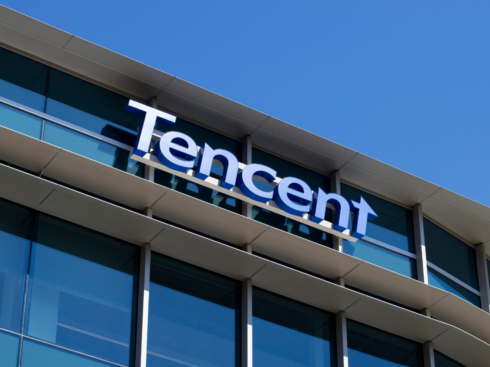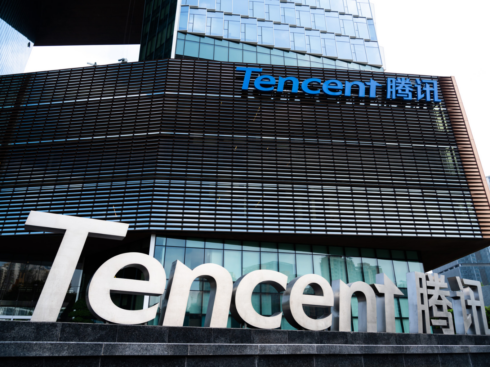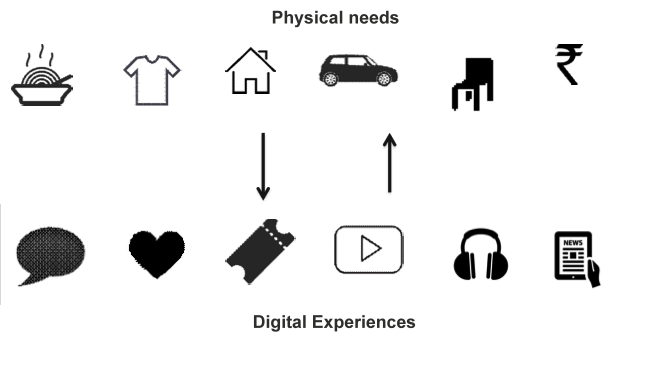This article is contributed by Nitin Sharma, Principal and founding team member at Lightbox. He has the rare fortune of having been in VC as well as in startup teams, both in the US and in India. Read his complete bio here
Question: How many Internet companies do you think are advertising on mainstream Indian TV channels? The answer might surprise you.
If you’ve been in India recently and turned the TV on, it’s hard to miss the relentless bombardment of ads by the growing number of funded tech companies in the new Indian Internet economy that we are all working to build. Be it an IPL or World Cup cricket game or an episode of The Big Bang Theory, every second ad seems to be about e-commerce or a mobile app. Some of us in the venture industry joke that the real winners of the Digital India boom are the ad agencies and TV networks.
Is TV working that well as a marketing channel? Is TV that important in a country like India, vs. China or the US? And aren’t tech startups supposed to run away from building brands in such an old-fashioned way?
It only happens in India
Let’s start with what’s going on. Obviously, what has happened in the Indian tech startup ecosystem since mid-2014 is unprecedented. From a capital standpoint, the ecosystem expanded 5x in just 1 year (~$5BN in financings, vs. $900MM in 2013). Round sizes, valuations, salaries have doubled and tripled, and marketing budgets have grown manifold.
ET says that ecommerce companies alone will spend 3,500 Cr (~ $600MM) in ads this year, and growing this at 50%+ annually. Looks like they’ll spend close to $100MM around IPL8 (a cricket league) alone.
What really strikes me is the number of advertisers involved. We did a rough count ourselves and came up with as many as 66 online / mobile companies that have been advertising on mainstream TV channels. That’s a LOT of companies, many of whom were scrappy startups not too long ago. The large players – from Amazon, Flipkart and Snapdeal to PayTM and ShopClues – EACH plan to spend between 150-500 Crores ($25-$100MM) in ads this year, and TV could account for almost 50% of that.
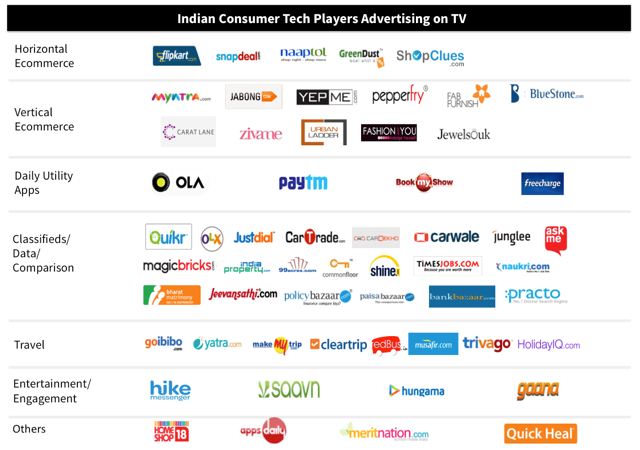

Unique to India – What’s fascinating is that nothing like this ever happened in the US or even China. I lived in the US for 12 years and don’t remember seeing any online brands on TV. One would think that China would have seen something similar, but having talked to a few contacts there, no one except a few players (Didi Dache, the taxi app being one), went big on TV.
Not just the big guys – In the snapshot above, there are startups that are at the Series B or C stage with smaller coffers. Given that you generally can’t have any campaign impact via TV unless you spend 4-6 Cr ($1MM) at a minimum, the early spending on TV is a bit surprising. Even a smaller (sub $10MM revenue) e-commerce player that we met last year had spent more than $1MM on TV in a single month last year.
Old-fashioned – And of course, it’s counter to the Silicon Valley wisdom of obsessing about and over-investing in your product. And being lean in your marketing by focusing on content, community and social / viral aspects. And being data-driven. When it comes to addressability, measurement, attribution or targeting, TV is ancient.
But here’s why it makes sense in a country like India
The obvious answer is “reach”, but given the high costs and the proliferation of regional / local channels, there’s more to it.
Shared social experience accelerates new behaviors – For most Indian households, TV viewing is still a shared social experience. And for most Indian households, concepts like e-commerce, taxi apps or mobile wallets are still new. And the reality is that in the typical Indian psyche, being on TV is a token of legitimacy. When you put it all together, one can see why TV is not a bad way to make new behaviors become mainstream, in many cases across generation gaps.
In fact, one should be grateful to the early spenders on TV. By carpet-bombing the consumer market with prime-time TV ads, they have now established new, mainstream behaviors.
In only a 1-2 year period, they have now caused mass awareness that shopping via your phone is not just possible, but the “cooler”, faster, cheaper way of doing things. That you would be an idiot not to buy movie tickets, recharge your phone or plan your travel on your smartphone itself. That the moment you get hungry, or see someone in pain or need to learn something, you should think only of your smartphone.
These behaviors had to be “created” for consumers beyond the large Metro cities and for the vast majority of Indians from whom the only exposure to the Internet is via a smartphone. Obviously, TV was an effective way to accelerate this “leapfrogging”. Come to think of it, this mass awareness, adoption and changing / reshaping of behaviors so quickly is something profound. Never before have hundreds of millions of consumers gone through such a quick change. The US or China have had 2-3 decades of more gradual change to get there. It will be particularly interesting to see if TV campaigns also open up new categories like online lingerie for example, where the offline buying experience in India is terrible and open conversations help break the taboo.
Over time, this burst of spending by the first movers will reduce Customer Acquisition Cost (CAC) for the next generation of startups, since the categories and concepts get established and the propensity to try new apps / services becomes stronger.
Trial and reinforcement – When it comes to an app, TV can lead to some instant trial (this is different from any other product or service), as you can download and play with apps right away. Seeing back to back ads for Flipkart and Saavn helps consumers figure out that the Internet can touch all their needs from physical goods to digital experiences. Some start their digital journey via engagement (chat, music, gaming) and move to commerce and services, and for others, it is vice versa.
Generating Organic / Search Traffic – Some of the vertical e-commerce companies we meet often have mentioned the limits to the effectiveness of pure digital ad spend – from the rising costs of keyword buying and the unevenness of ROI with Facebook. In some cases, the TV campaigns are actually more impactful in generating direct or organic search traffic.
In one e-commerce company we have seen, mobile traffic increased 6X in 9 months via a modest TV campaign, and came up to over 60% of total traffic, contributing to doubling of transactions in the same period.
In another case, a one-month burst of about 6 Cr led to a 50% jump in monthly revenue, which was sustained. In this case, one could roughly argue that the TV spend paid back in about 12 months, plus the lingering brand creation effect.
However, with all multi-channel advertising, there is always the problem of “attribution”, that of knowing what effect can be attributed quantitatively to any one means of advertising vs. the other. How does one know that the purchase was prompted by a TV ad seen 2 days ago, vs. a display ad seen this morning, or vice versa?
Race to Own Categories – For better or worse, a lot of what’s going on is a sudden irrational race to dominate spaces that are just emerging. The premium from being #1 is perceived to be perhaps 10x the value of the #2 player. Among both investors and entrepreneurs, there is an intense FOMO (fear of missing out). TV gives you “Share of Voice”, and multiple competing startups are of course feeling the herd mentality pressure to jump on the TV bandwagon.
As long as Awareness / “Deals” are not confused with Brand
I think the biggest pitfall of heavy TV ad spend is just that it is diverting focus and resources away from far stronger ways of brand-building where loyalty and evangelism is much stronger: great UX, great content marketing, etc. Too many tech companies in India are becoming addicted to the drug to fuel growth. The medium is becoming quite noisy and it’s becoming harder for ads to stand out. In the process, Internet startups are probably missing opportunities to really connect with the customer on a deeper level.
Many of the TV campaigns are simply re-emphasizing the “deal” driven nature of e-commerce in India. Are brands really being built? Mahesh Murthy has some strong thoughts on this.
There’s also a tricky aspect around execution of these campaigns. Here is afunny take from ET on an e-commerce company’s relationship with media agencies. It’s a collision of two different worlds:
(a) startups don’t have 5 year horizons like traditional brand builders
(b) startups have to be overly focused with call-to-action vs. generic branding
(c) metrics like GRPs mean nothing to startups, if they don’t result in app downloads or traffic
(d) startups want to be able to “pivot’ their campaigns quickly, vs. the old-fashioned 6+ week campaigns
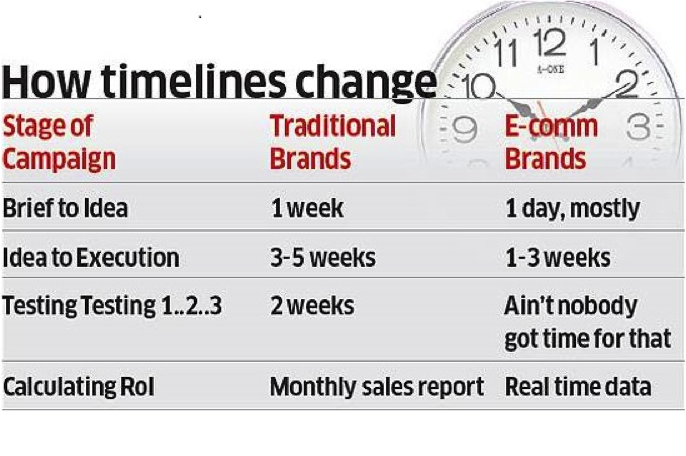 Stage also matters. If startups haven’t even had a few years to develop their internal brand and culture, how can they truly build a lasting brand externally? My colleague Tina Mehta has penned some thoughts on the role of design and the role of culture in branding.
Stage also matters. If startups haven’t even had a few years to develop their internal brand and culture, how can they truly build a lasting brand externally? My colleague Tina Mehta has penned some thoughts on the role of design and the role of culture in branding.
As for our own companies, Greendust and Cleartrip have been on TV in a limited way after they reached a certain stage, which has helped. They will continue to explore TV and other traditional media, but maintain a sharp focus on the core value proposition. Greendust’s unique business model (refurbished, quality products with a warranty) has resulted in them being one of the larger players in tech-enabled commerce, and low customer acquisition spend. Cleartrip has always focused far more on innovation in design and UX. Similarly, among our new companies, Embibe, Furlenco and Faasos, the opportunity and challenge is to build scale and uniqueness (especially on mobile) without relying on heavy media spends.
Digital vs. TV in the future
It is interesting to look at what happened in China in a matter of just three years. In the 2011-12 timeframe, “nearly half of the advertising dollars went to television and just 14% went to digital, according to ZenithOptimedia..Next year, companies are expected to spend more money on digital advertising than on TV campaigns.”
Will we see something similar in India? I think so, though the change might take longer. This will have huge consequences on how growth-stage startups think about their marketing. Budgets will move to more performance-driven approaches or innovative brand-building (true personalization for example). As a side effect, this should be a boon for engagement-led platforms (gaming, dating, news, video, etc.) that rely on ad revenue models.
Given the importance that TV continues to have in Indian life and society, TV advertising will remain a very effective option for consumer tech companies, as long as they can have a unique voice, not just a share of voice.








